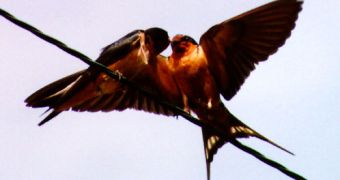There is a common concept amongst biologists about sexual selection and that many exaggerated male traits are the result of it.
For example, sexual selection is regarded behind the peacock's tail or deer's antlers.
But a team of Exeter and Cambridge universities has proven a common example of sexual selection to be in fact ... natural selection.
In other words, that's not the result of a beauty choice, but of the fitness.
They showed that differences in the lengths of the tail feathers of the male barn swallows are more linked to their aerodynamic ability than being attractive.
Their "streamers" have been cited even by Darwin as an example of sexual selection as females indeed preferred males with longer Tails.
This is the first time when barn swallow females are showed to select males with longer, more aerodynamic tails, rather than on the basis of attractive but useless ornaments.
By investigating the variation in the individuals' tail lengths, the researchers determined the ideal tail length for executing best maneuvers while catching insects and then assessed how much the tail had been enlarged beyond this.
They were surprised to see that the optimal streamer length for flight, even if not the same between individuals, had not extended, on average, beyond this, thus the size of tail "ornaments" was dictated by natural selection and not sexual selection.
"The part of the streamer thought to be ornamental, rather than functional, does not vary between individuals. This means that swallow tail streamers are not true ornaments. The streamer's purpose may just be to signal the sex of the individual, rather than to communicate attractiveness to choosy females. We believe that overall tail length is performing the function of attracting females, but females are choosing between males on the sensible criteria of how good they are at flying and catching prey. The ornamental part of the tail is simply saying 'I am male'." explained Professor Matthew Evans of the University of Exeter.
Sexual selection chooses traits with no practical role but natural selection sorts for the fittest variants.
Thus, swallow females employ this useful information, transmitted by tail length, to select the best insect hunters.
"The results of this study force us to question long-term assumptions about the nature of ornamentation and sexual selection," ended Evans.

 14 DAY TRIAL //
14 DAY TRIAL //